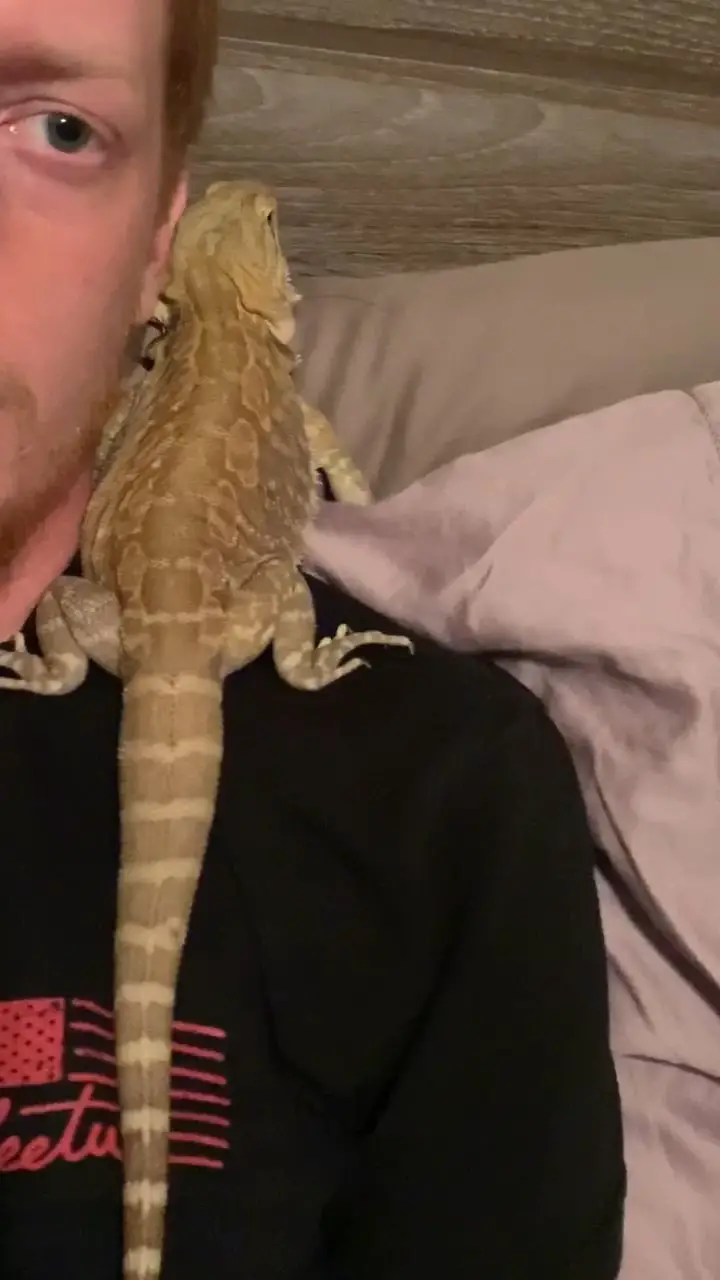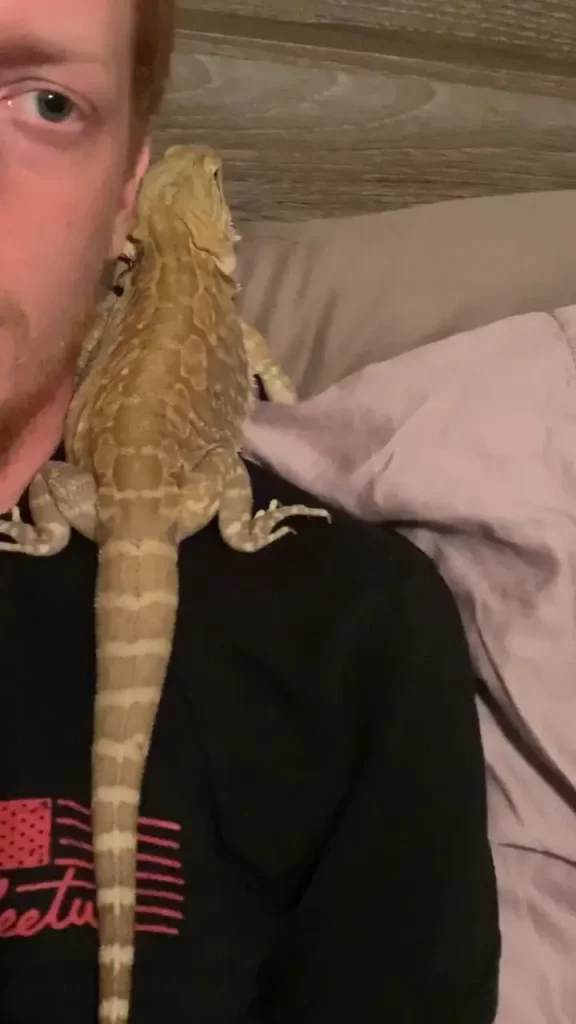Bearded dragons are fascinating creatures that bring joy and companionship to many pet owners. However, at times, their behavior can be perplexing, leaving owners wondering what they are trying to convey. One such behavior is when bearded dragons wiggle on their owners, and this article aims to explore the reasons behind this seemingly odd behavior.
If you’re a bearded dragon owner and have ever wondered why your pet wiggles on you, you’re not alone. This behavior can be a sign of many things, from affection to discomfort, and it’s essential to understand what your pet is trying to tell you. So, let’s dive into the world of bearded dragon behavior and explore the reasons behind this curious action.

Understanding Why Your Bearded Dragon Wiggles on You
1. Comfort and Security
Bearded dragons are known to be very sociable creatures, they enjoy socializing and spending time with their owners. When your bearded dragon wiggles on you, it could be a sign that they are comfortable and feel secure in your presence. This is because they trust you and have developed a bond with you over time. The wiggling could also be a way of showing affection and wanting to be close to you.
It is important to ensure that your bearded dragon has a comfortable and secure environment to live in. This means providing them with a spacious and clean enclosure, a proper diet, and regular interaction with you. By doing this, your bearded dragon will feel happy and content, and will be less likely to show signs of stress or discomfort.
2. Communication and Attention
Another reason why your bearded dragon might wiggle on you is that they are trying to communicate with you or seeking your attention. Bearded dragons are very expressive animals, and they use body language to communicate their needs and desires. The wiggling could be a way of trying to tell you that they want to play, eat, or get some attention from you.
If your bearded dragon wiggles on you, it is important to pay attention to their behavior and body language. This will help you understand what they are trying to communicate with you. By responding to their needs and providing them with the attention they require, you will strengthen your bond with your bearded dragon, and they will be happier and healthier as a result.
3. Shedding and Restlessness
Bearded dragons shed their skin regularly, and during this process, they may become restless and agitated. The wiggling could be a sign that they are uncomfortable due to their shedding skin. It is important to ensure that your bearded dragon has a proper shedding environment to help them during this process. This could include providing them with a humid hide, a proper diet, and plenty of water to drink.
Restlessness could also be a sign of other health issues such as parasites, dehydration, or infection. It is important to monitor your bearded dragon’s behavior and seek veterinary care if you notice any unusual or concerning symptoms.
4. Hormonal Changes
Bearded dragons are known to undergo hormonal changes during breeding season, which typically occurs during the spring and summer months. During this time, your bearded dragon may become more active and restless, and may also display mating behaviors such as head-bobbing and arm-waving. The wiggling could be a sign that they are feeling the effects of these hormonal changes.
If you have a male and female bearded dragon, it is important to ensure that they are housed separately during breeding season to prevent unwanted breeding. It is also important to provide your bearded dragon with a proper diet and plenty of water during this time to help them cope with the hormonal changes.
5. Playful Behavior
Bearded dragons are playful animals, and they enjoy interacting with their owners. The wiggling could be a sign that they are in a playful mood and want to play with you. They may want to chase your fingers, climb on your shoulder, or simply cuddle with you.
Playing with your bearded dragon is an important part of their socialization and can help strengthen your bond with them. It is important to provide them with a safe and comfortable environment to play in, and to supervise them at all times to prevent any accidents or injuries.
6. Health Issues
In some cases, the wiggling could be a sign of underlying health issues. This could include respiratory infections, metabolic bone disease, or other medical conditions. If you notice any unusual or concerning symptoms, such as lethargy, loss of appetite, or difficulty breathing, it is important to seek veterinary care immediately.
Regular veterinary check-ups are important to ensure that your bearded dragon is healthy and happy. Your veterinarian can also provide you with advice and guidance on how to provide the best possible care for your bearded dragon.
7. Age and Growth
Bearded dragons grow rapidly during the first year of their life, and during this time, they may become more active and restless. The wiggling could be a sign that they are experiencing growth spurts and are feeling the effects of their rapidly changing bodies.
It is important to provide your bearded dragon with a proper diet and plenty of water during their growth phase to help them cope with the changes. You may also need to adjust their enclosure to accommodate their growing size and provide them with plenty of space to move around.
8. Temperature and Lighting
Bearded dragons require specific temperature and lighting conditions to thrive. The wiggling could be a sign that they are too hot or too cold, or that they are not receiving enough light or UVB radiation. It is important to ensure that your bearded dragon’s enclosure is properly set up with the right temperature gradient, lighting, and UVB radiation.
If you notice any unusual or concerning behavior, such as lethargy or loss of appetite, it could be a sign that your bearded dragon is not receiving the proper environmental conditions. It is important to seek veterinary care immediately if you notice any unusual or concerning symptoms.
9. Personality and Temperament
Each bearded dragon has its own unique personality and temperament. Some bearded dragons are more social and outgoing than others, while others may be shy or reserved. The wiggling could be a sign of your bearded dragon’s personality and temperament.
It is important to spend time with your bearded dragon and learn their personality and temperament. By doing this, you will be able to provide them with the best possible care and ensure that they are happy and healthy.
10. Natural Behaviors
Lastly, it is important to understand that wiggling is a natural behavior for bearded dragons. They may wiggle when they are excited, happy, or simply want to explore their surroundings. By understanding your bearded dragon’s natural behaviors, you will be able to provide them with the best possible care and ensure that they are happy and healthy.
It is important to provide your bearded dragon with a comfortable and secure environment, a proper diet, and regular veterinary care to ensure that they are healthy and happy. By doing this, you will strengthen your bond with your bearded dragon and enjoy many happy years together.
Freequently Asked Questions
Why Does My Bearded Dragon Wiggle on Me?
Bearded dragons are known for their calm and docile temperament, but they can also be quite active and wiggly. Here are some reasons why your bearded dragon might wiggle on you:
Firstly, your bearded dragon might be trying to get comfortable. Bearded dragons have a preferred temperature range, and if they’re too hot or too cold, they might squirm around to find a comfortable spot. Make sure your bearded dragon’s enclosure is set up with a basking area and a cooler area, so they can regulate their body temperature as needed.
Secondly, your bearded dragon might be trying to communicate with you. Bearded dragons are social animals and they might wiggle or move around to get your attention or show affection. Try interacting with your bearded dragon in different ways, such as petting or hand-feeding, to see if they respond positively.
How Can I Train My Bearded Dragon to Stop Wiggling on Me?
Training your bearded dragon to stop wiggling on you can be a slow process, but it’s possible with patience and consistency. Here are some tips for training your bearded dragon:
Firstly, start by handling your bearded dragon for short periods of time and gradually increase the duration as they become more comfortable. Use a gentle touch and speak to them in a calm voice to help them feel secure.
Secondly, provide your bearded dragon with plenty of enrichment and stimulation in their enclosure, such as climbing structures, hiding spots, and toys. This will help them burn off excess energy and be more relaxed during handling sessions.
Remember, training your bearded dragon takes time and effort, so be patient and consistent in your approach. With time, your bearded dragon will become more comfortable with handling and may even enjoy spending time with you.
Girl pretends to fall asleep to see what her Bearded Dragon will do…
In conclusion, there are several reasons why your bearded dragon might wiggle on you. It could be a sign of discomfort or anxiety, especially if they are not used to being handled. It could also be a way for them to communicate with you, expressing their need for food, water, or a change in environment. And sometimes, it could simply be a behavior that they enjoy doing.
Regardless of the reason, it’s important to pay attention to your bearded dragon’s body language and behavior, and to handle them gently and with care. By understanding their needs and preferences, you can build a stronger bond with your pet and ensure their health and happiness. So, next time your bearded dragon wiggles on you, take a moment to observe and interpret their behavior, and respond accordingly.


